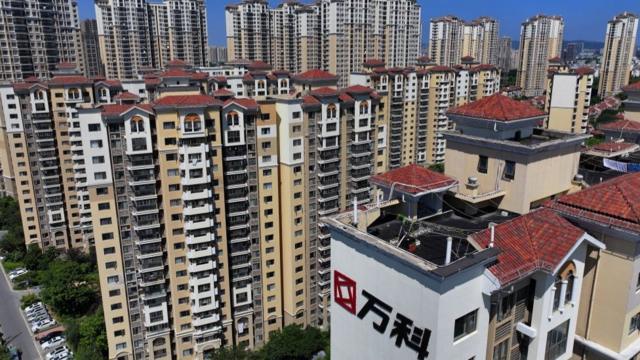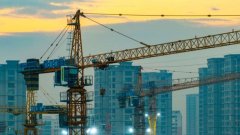
image source, getty image
The decline in China's real estate market continues.Real Estate Data Institution Ker Rui said that in the first quarter of 2024, the total number of housing companies achieved a total of 779.24 billion yuan, a significant decline of 47.5%year -on -year.
Official data shows that house prices are also going down.China Statistics Bureau announced the change in sales prices in 70 large and medium -sized cities in February, of which the sales prices of new commercial housing and second -hand houses in 70 large and medium cities decreased by 0.4%and 0.6%respectively.It has fallen for 9 months and 10 months, respectively.
A report from Anbang Think Tank pointed out that although the second -hand housing market has changed positively, the general trend of the entire real estate market has gradually sank, and it is difficult to change, and the cold winter of the real estate market is far from the past.
At the same time, China ’s“ two sessions ”in March vigorously publicize“ new productive productivity ”and hope to use this to replace traditional industries such as real estate to drive the economy.In the state of the market, can these industries under these "new productive productive" concepts match and fill the real estate industry with huge volume and long upstream and downstream industrial chains to the original contribution of macroeconomics and employment?
Status analysis: Not yet to the bottom
The most remarkable real estate news since April is that Vanke, a leading real estate company in China, has been in trouble.Different from Evergrande, Vanke is a "good student" in Chinese real estate companies. It has predicted risks very early and reduced leverage.But the continuous market downturn has made this company start to survive.
On March 28, Vanke released 2023 reports showing that last year's net profit was 12.16 billion yuan, a decrease of 10.53 billion yuan in 22.69 billion yuan in 2022, a decrease of 46.4%.In the case of a significant reduction in profits, the management of Vanke Group has collectively cut salary.

image source, getty image
"Vanke, Goldland, etc. 'high -quality' housing companies, once again facing the crisis of 'explosive thunder' crisis, Country Garden, Evergrande and other exporting real estate companies 'lying" lying down', the market's clearing is far from being realized. "Anbang Think Tank reportAccording to analysis, this means that the Chinese real estate market not only has the "spring" of the soft landing, but the cold winter with imbalanced supply and demand is far from the past.It is necessary to be adequately prepared for the long -term nature of the real estate market.
Some experts also believe that 2024 will be a year when the Chinese property market is undergoing a rebound.
Wang Tao, head of economic research and chief Chinese economist in Asia, said at a media meeting in March that the short -term real estate market is still facing certain risks. UBS predicts that the start and sales area will decline in the first half of the year.It may be stable in June and July in the middle of the year. It may rise slightly in the second half of the year. It is expected that the construction area will decrease by 10%and the sales will fall by about 5%.
Real estate skills and overwhelming
China has implemented housing reform in the late 1990s, opening up the "big age" of the real estate industry -then the then Prime Minister Zhu Rongji announced that the era of welfare was ended and the era of residential commodity opened.
The report of the Bank of China Research Institute describes that the real estate industry has the characteristics of long industrial chain and many related industries.On the one hand, real estate development activities and construction industry production activities are inseparable. During the real estate development process, the development of cement, steel, glass, hardware, ceramics, chemicals, etc.Housing -related consumer activities will promote the development of manufacturing industries such as home appliances, furniture, and home textiles.In addition, real estate development and sales will have a strong driving effect on the tertiary industries such as logistics and finance.
The research report of Southwest Securities is more direct -the sum of the total driving effect of the real estate industry in 2017 is about 1.71, which means that each increase in the output value of the real estate industry in 1 unit will drive the output value of 1.71 units in the entire industry.
Official data shows that in the past 20 years, real estate is a well -deserved pillar industry in China -7.34%of GDP, and 9.9%of the relevant industries that are indirectly driven, and about 17%of GDP.
In 2020, the added value of China's real estate industry reached a historical high, 7.5 trillion yuan, about $ 1 trillion.If it is regarded as an economy, China's real estate industry is roughly equivalent to the national GDP of Mexico or Indonesia, ranking about 15 in the world.
Not only is the proportion, but also the contribution rate of economic growth is greater.Economist Ren Zeping calculated in a report that between 2000 and 2020, the real estate industry's contribution to GDP growth fluctuated from 4.8%, reaching 13.9%.
This means that at the time, one -seventh of the Chinese economy's new parts from the previous year came from the real estate industry.
At the same time, local governments also sell land in this process to enrich the finance; residents buying a house "get on the car" to achieve value -added assets under rising house prices;The scale seems to achieve a rare and win -win situation.
But the problem gradually appears.Yang Yang, a real estate assistant professor at the Chinese University of Hong Kong Business School, previously pointed out four issues: bank loans gave real estate, manufacturing technology industry could not get loans, real economy void; high housing prices in first-, second -tier cities, high inventory in third- and fourth -tier cities, high inventory,Supporting and demand mismatch; local governments have rely on land finances in the past and need to be transformed; guaranteeing housing and housing leasing systems need to be improved.
In other words, the rapid development has caused China's asset prices to continue to rise. Both the enterprise and the residents are borrowing loans, and the risks are constantly accumulating.
Earlier 20 years, the Chinese property market has also experienced several rounds of ups and downs, but this time the downside is quite different."Using more policies, the real estate industry cannot return to the past." Wang Tao said that the current change in the property market is a structural change, and we must adapt to it instead of reversing.
"But it is still necessary to introduce some boost measures so that the downlink of real estate will not over -adjust, and will not have a large negative impact on other economic departments, enterprises and residents." Wang Tao said.
Replacement Industry
"The downside of real estate is structural, long -term, and long -term, which is related to factors such as aging population, excess real estate, and high debt of real estate companies, so I feel that it is necessary to change to new aspects." Wang Tao said.
Ing Bank's chief economist Song Linxiang said that from a large perspective, the old growth engine behind China's economic growth miracle, including globalization, urbanization, industrialization, population dividends, and debt -driven growth.It is weakened to varying degrees.
"Therefore, we must find new growth momentum, which is also the key areas of the two sessions. Green economy, digital economy and innovation are long -term strategic directions."
But the impact of the economic volume on the economy is not easy to replace.
Taking employment as an example, there is calculation of 2021 Chinese real estate involves about 15 million employees, and from the perspective of employment of urban personnel, from 2004-2020, the number of real estate employment in urban personnel increased from 1.3 million to 5.25 million.The compound growth rate is 9.12%, which is much higher than the growth rate of 2.7%of the total number of employment in urban and towns.
Not only that, real estate can drive more than 28%of the employment flexible changes in more than 28%of the upstream and downstream industries, that is, the employment absorption capacity brought by the added value of the real estate industry accounts for about 30%.
In other words, the real estate industry is like a sponge. When developing well, it can absorb a large number of employment. When the downturn, the crowded employees also put pressure on the employment market.
26 -year -old Zhang Jingjing is one of themFor example, she introduced to the real estate industry for sales after graduating from university in 2019, but after three years of bumps, she was forced to leave, switch to the housekeeping industry, took off the suit, and put on a casual dress. She became a "blue -collar" labor.By.
In contrast, the new energy vehicle industry, which has been highly hoped, although "seeking sages and thirst", but in terms of employment, it is a magnitude different from the real estate industry.It is said that by 2025, the total number of talents of energy conservation and new energy vehicles will reach 1.2 million, and there will still be about 1.03 million gaps.
The downturn in the real estate industry, the first to affect the two parts: real estate development and operation and real estate intermediary services. According to China's latest economic census data, these two parts account for 29%and 13%of the industry, respectively.It is difficult to adapt to jobs in new industries such as new energy vehicles.
"Human Resources Mistration" appears in the process of replacement of the pillar industry.Song Lin explained this that the new growth momentum cannot fill the gap of slowdown in the growth of the old economic model.Unlike old economic driving forces such as real estate and infrastructure investment, the results of the development of new economic development are often concentrated in the hands of a few people, and the old economic driving force is characterized by many people with long supply chain and supporting, such as real estate.

image source, getty image
Moreover, the rising path of emerging industries is not a pace, and there are still variables.
Wang Tao reminded that it is not that everyone must go to photovoltaic and new energy vehicles. This may be a misunderstanding. It is necessary to develop all emerging industries. In fact, it will cause excessive competition and over -investment.
U.S. Treasury Secretary Yellen recently visited China also named "overcapacity" in industries such as new energy vehicles and photovoltaic industries that would harm related industries in Europe and the United States.
In fact, China's new energy vehicle exports have grown too fast in a short period of time, which has impacted similar industries in destination countries and has made trade protectionism.
Taking one of the European Union as an example, 14 million people in Europe directly or indirectly hire in the automotive manufacturing industry, equivalent to 6.1%of the EU's employment population.In this context, the European Union launched a counter -subsidy survey of Chinese electric vehicles last 10 last year, which may increase its tariffs from the current 10%to at least 20%.
The United States has imposed an additional 25%tariff on Chinese exports from Trump. At present, there are still voices that the authorities have blocked the loopholes of Chinese automobile products to bypass Mexico to enter the US market.
Wang Tao believes that new productivity actually includes the upgrading of traditional industries and an industry that can improve the productivity of the whole factor. Therefore, from the perspective of full factor productivity, it is actually a better allocation of resources in various industries to allocate resources to allocate resources.Including labor, capital, land, raw materials, scientific and technological talents.




